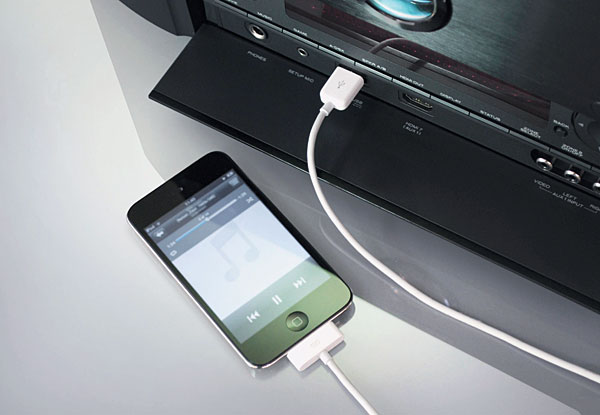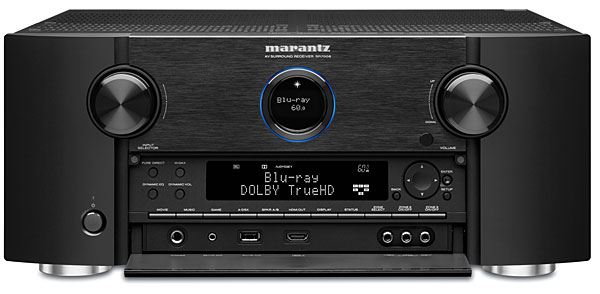Marantz SR7008 A/V Receiver Page 2
 Oz the Great and Powerful is a hybrid animated prequel to The Wizard of Oz. What the disc identified as the English 7.1 DTS-HDMA Near Field Audio Mix first comes alive in the tornado scene, shifting from center-channel mono to full surround. Though the receiver was well broken in by this time, it needed a little warmup after powering up, with the orchestra sounding smoother after the first hour. Perhaps that’s the price of a top end that doesn’t slather the truth in vagueness. In the last half hour of the movie, as the trombones shuddered nervously and witches and apparitions shot fireballs out of their mouths, the receiver handled dynamically challenging material without losing its grip on timbre, imaging, soundfield integrity, and bass authority.
Oz the Great and Powerful is a hybrid animated prequel to The Wizard of Oz. What the disc identified as the English 7.1 DTS-HDMA Near Field Audio Mix first comes alive in the tornado scene, shifting from center-channel mono to full surround. Though the receiver was well broken in by this time, it needed a little warmup after powering up, with the orchestra sounding smoother after the first hour. Perhaps that’s the price of a top end that doesn’t slather the truth in vagueness. In the last half hour of the movie, as the trombones shuddered nervously and witches and apparitions shot fireballs out of their mouths, the receiver handled dynamically challenging material without losing its grip on timbre, imaging, soundfield integrity, and bass authority.
Room Correction vs. Unvarnished Amp
A receiver with high-quality amplification drives me deep into my vinyl library. Much of the music listening focused on this question: When Audyssey MultEQ XT32 interacts with an inherently good-sounding amp, does it help or hinder music? Different music brought different results.
Nick Drake’s Bryter Layter is his most elaborately produced album. In the MultEQ or pure direct modes—meaning with or without room correction and other processing—the Marantz layered most of the carefully balanced midrange elements like a master. But there were exceptions. In pure direct, I became more and more irked by the interaction between my room’s natural standing-wave-induced bass hump and Drake’s chest resonance as well as his lower guitar strings. Both elements had been exquisitely mixed to optimize bottom-end fullness, and without room correction, that fullness tipped over into bloat. MultEQ smoothed out the midbass to make it proportionate with the rest of the music. The Audyssey Flat mode sounded slightly more detailed than the just-plain-Audyssey mode, but both did the job beautifully.

The Marantz did well with classical music. Beethoven’s “Eroica” Symphony arrived on a London Phase 4 LP with Carlos Paita conducting the Scottish National Orchestra. Pure and room-corrected modes both delivered a long, luscious decay that fostered a true concert-hall feeling. The pure mode brought more warmth and body to the strings—I’m guessing London/Decca’s engineers were counting on some benign room interaction in playback—while MultEQ emphasized the leading edge. The pure mode was better integrated; the room-corrected mode was more revealing. They both sounded good, so it was a draw. When you go for a walk in the forest, is it the forest that interests you, or the trees?
Led Zeppelin’s Physical Graffiti is less a unified album than a mixed bag, produced in different sessions from 1970 to 1974, many of them recorded with mobile studios. Fertile it is; consistent it is not. In several tracks recorded spatially flat with little reverb, like “Houses of the Holy,” MultEQ gave the guitar more sting, but at the expense of rhythmsection whomp. Without room correction, I liked playing it louder, always an advantage with Zep. But in tracks with more reverb, room correction brought out more texture and detail. “Kashmir” entranced me as the vocal sailed over the innovative blend of natural strings and mellotron. While I’m not a big fan of phase shifters, the processing on “Bron-YrAur” gave the ruminative acoustic guitar track an authentic haze-of-the-1970s feel, and MultEQ brought out more of its time-machine texture.

The Marantz SR7008 is yet another masterful receiver from a brand that has remained great despite repeated changes in ownership. With every new product, Marantz earns its stripes all over again, and as the years go on, I become increasingly impressed by how many deeply satisfying Marantz receivers I can look back upon.
I will say that feature-wise, Marantz ought to try harder. A top-of-the-line receiver must be able to play music files from a PC or Mac without going through a DLNA connection. And with Wi-Fi proliferating in receivers costing well under a thousand dollars, Marantz needs to add at least an optional wireless alternative to the Ethernet jack. Not everyone can string Ethernet from router to rack.
But then there’s the sound. A couple of years ago, I nearly adopted this model’s predecessor, the SR7007, as my reference receiver. The SR7008 is equally worthy of that honor. Sound-wise, your two thousand bucks couldn’t be better spent.


























































